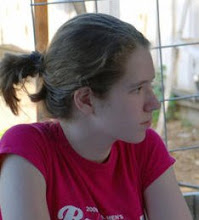Saturday, October 8, 2011
Oh... those dwarfs
So at 6:30am, dark O'clock, I woke up in a panic and not sure why. I lay staring at the ceiling for half a minute. Then I heard what must have woken me up: an unmistakable rabbit scream. I was froze stiff and in a cold sweat. I was somewhat in a daze and in denial about what I was hearing. I listened as mom slid open the glass door to check on what was going on. I didn't get up, afraid of what I might see. My rabbits always seem to die in a way that is traumatic usually in the middle of the night. Thoughts flashed, "What if it's one of my convention rabbits."
Friday, March 11, 2011
Balancing Number and Breeds
How many breeds is too many? You've seen them at shows: breeders with seven different breeds trying to get three of them on the table. Why do they choose to raise so many different rabbits? When you think about it, how can people do well with half a dozen breeds? When looking at Best in Show winners, how many breeds do they have? In general, I stop taking people seriously after three breeds. With one breed taking many months of work, one cannot raise five without slacking in most areas. But wait, there are many exceptions to this rule.
Finding your breed - If you're lucky, you found your breed early on in your rabbit career. A Jersey Wooly was the first purebred I bought. Almost by accident: Lance had run out of Netherlands and Hollands so I went with my third choice. What a choice! But in many cases, breeders need to date at least a few breeds before finding Mr. Right.
Kayte Garren from Big Ears Little Ears Rabbitry 'kissed' at least five different breeds before narrowing her choice. Kristen Drum from Keep's Rabbitry played with Hollands and Mini Lops before deciding she wanted a rabbit to brush. (She recently wrote an article related to finding your breed: http://keepsrabbitry.blogspot.com/2011/03/changing-breeds.html)
The fact is, you may have to try out a few breeds to help you really know what you want in a breed. It's truly a dating game.
Breeds to Holes Ratio - I find that magic number to be at least 20 holes per breed. This way, you have the space to grow out juniors, own at least two lines, and have plenty of choices when playing The Bachlorette in the rabbit barn. It simply doesn't work out if you plan on doing well with a trio and 5 holes. Especially with breeds that never finish growing out or breeds that easily squeeze out eleven babies.
Ryan Kish raises Holland Lops, Netherland Dwarfs, Mini Rex, English Lops, and Californians. Let me tell you, those breeds have taken off. Ryan and his family have committed a lot of time and effort into their project. Their secret, besides starting out with some stellar stock, is having enough space to manage it. With 100+ holes, though it takes a lot of time, there is plenty of room for each breed to blossom.
Time Commitment - You can't have Ryan Kish's or Lance Higbee's 100+ holes without considerable time commitment. I know a lot of casual rabbit breeders who have other focuses such as horses, sheep, or cattle. It's fine to have small rabbit project on the side. It's important to remember that to only take on what you have time for. The same goes for breeds. Not only will you have to take on the extra care of the rabbits, this also means more breeding records and pedigrees to shuffle through. Adding new breeds makes record keeping and planning more complicated.
A New Challenge - Some breeders who are becoming successful in rabbits begin seeking new challenges. Some people immediately take on a new breed. In many cases, it's a breed you've admired for a long time or maybe it's a breed similar to your established breed. Although it may sound like a fun idea at the time, some people regret the decision. Remember, a new breed adds to the time commitment and can remove the time you put into your original breed.
Susie Cederlof from Haute Wooly Coutre took on a new challenge: Tri and Harlequin woolies. A color project is a great way to start a new challenge without having to learn a new breed, or manage correcting type on a new animal. Instead of involving herself in a new breed, she took the leap to start a hefty color project. To that Susie, I wish you the best of luck.
Similar Breeds - Finally, I find it acceptable to raise many similar breeds. Take angora breeders for example, they often raise 4-5 different breeds (including German Angoras) Meat breeders can manage many different types of breeds including Californians, New Zealands, Satins, and Rex.
In reality, it's about finding your balance. If you choose to specialize in your breed so you can have the space for careful consideration of your rabbits, that's great. If you decide your 4th breed will be a trio of Satins as a learning experience, go for it! Just remember that you must plan and consider what you really want from a breed. Set a new goal, evaluate those juniors, and don't bite off more than you can chew.
Subscribe to:
Comments (Atom)

